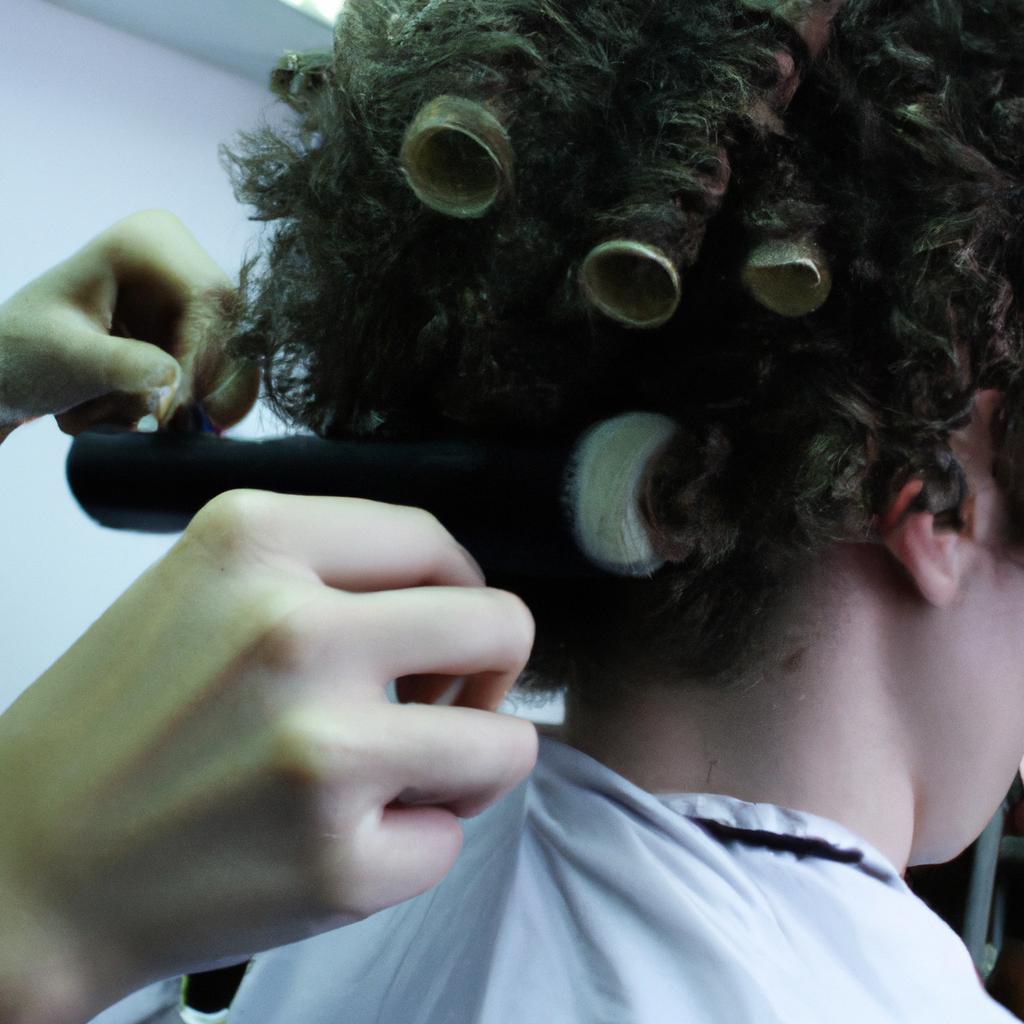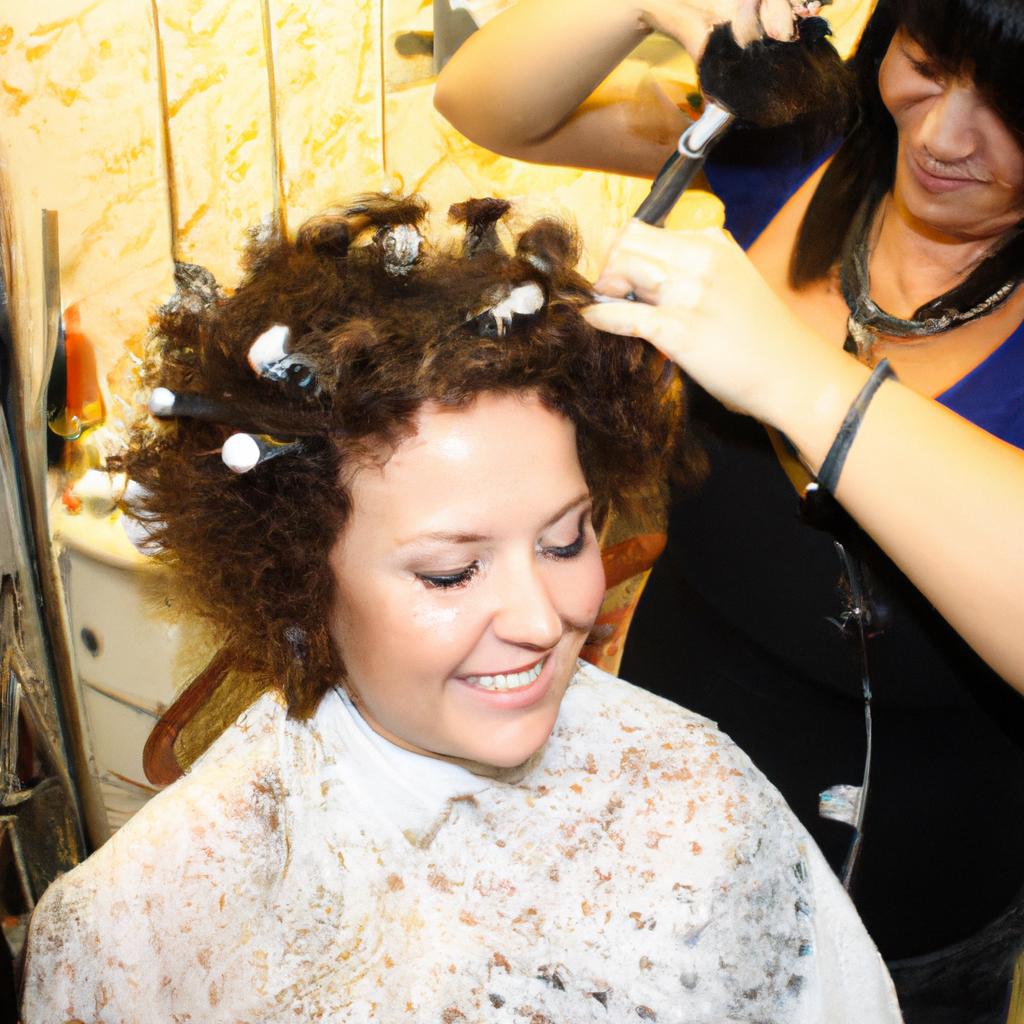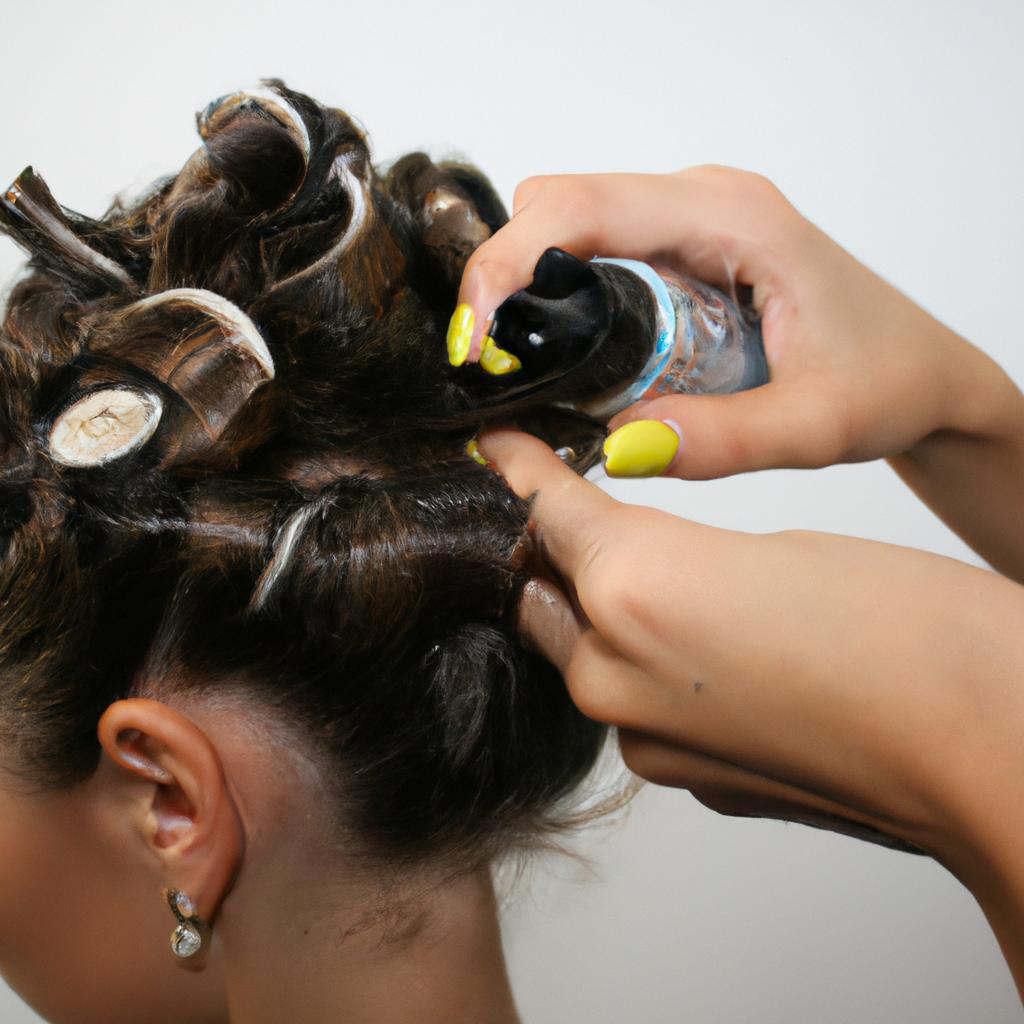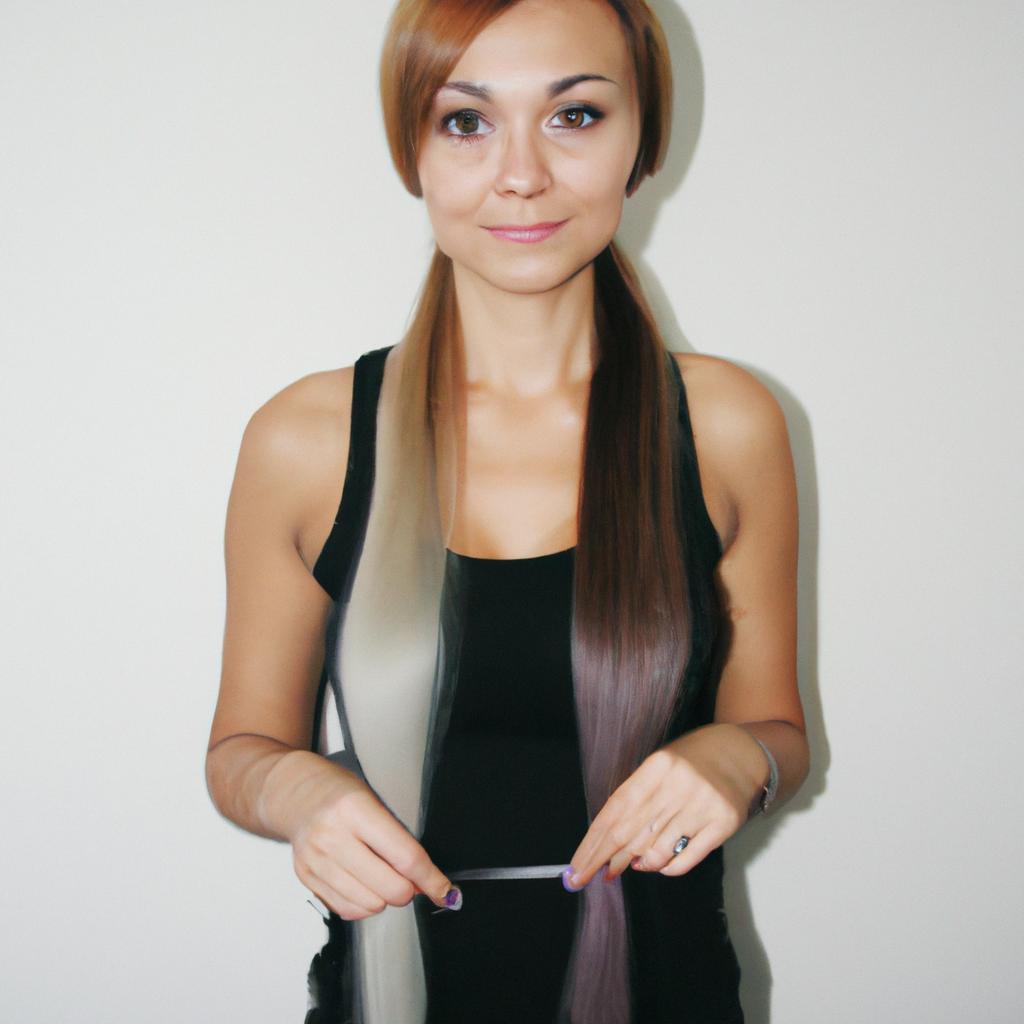The quest for perfectly styled hair is a timeless pursuit, and one technique that has stood the test of time is the perm. A perm, short for permanent wave, involves chemically altering the structure of the hair to create long-lasting curls or waves. The results can be stunning when done correctly, but achieving that perfect perm requires skill and expertise found at a professional hairdressing salon.
Consider Sarah, a young woman who had always dreamed of having voluminous curls cascading down her shoulders. After years of struggling with flat and lifeless locks, she finally decided to visit a reputable hairdressing salon for a perm. The skilled stylist carefully examined Sarah’s hair texture and listened attentively to her desired outcome. With precision and care, the stylist applied the appropriate chemicals to transform Sarah’s straight strands into gorgeous bouncy curls. This case study exemplifies how selecting an experienced hairstylist at a reputable salon can make all the difference in achieving flawless perms.
Perms have come a long way since their inception in the early 20th century, evolving from harsh processes that damaged hair to modern techniques that prioritize hair health while delivering stunning results. In this article, we will explore various tips and tricks for achieving perfect perms at the hairdressing salon , as well as provide information on how to maintain and care for your perm once you leave the salon.
-
Choose a reputable salon: When it comes to getting a perm, it’s crucial to choose a salon with experienced hairstylists who specialize in perms. Look for salons that have positive reviews and recommendations from previous clients. This will ensure that you’re in good hands and increase the chances of achieving the desired results.
-
Consultation is key: Before undergoing a perm, schedule a consultation with the stylist to discuss your hair goals and expectations. The stylist will assess your hair type, texture, and condition to determine the best approach for your perm. Be open about any concerns or questions you may have during this process.
-
Prepare your hair: It’s important to prepare your hair before getting a perm. Avoid washing your hair 48 hours prior to the appointment, as natural oils help protect the scalp during the chemical process. Additionally, refrain from using any styling products or heat tools that can damage or weaken your hair.
-
Trust your stylist: Once you’ve chosen a stylist and discussed your desired outcome, trust their expertise throughout the process. They are trained professionals who know how to achieve optimal results while prioritizing the health of your hair.
-
Follow aftercare instructions: After getting a perm, it’s crucial to follow the aftercare instructions provided by your stylist. This may include avoiding excessive moisture or heat exposure for a certain period of time, using specific products designed for permed hair, and scheduling regular trims to maintain healthy ends.
-
Use appropriate products: Invest in high-quality products specifically formulated for permed hair. These products are designed to nourish and enhance curls while minimizing frizz and maintaining longevity.
-
Protect from external factors: Protecting your permed hair from external factors such as sun exposure, chlorine from swimming pools, or excessive humidity is essential in maintaining its shape and health. Consider using protective sprays or wearing a hat when necessary.
-
Regular maintenance: As your hair grows, the perm will eventually grow out and lose its shape. Schedule regular appointments with your stylist to trim any split ends and refresh the curls if desired.
Remember, achieving perfect perms requires patience and proper care. With the right salon, stylist, and aftercare routine, you can enjoy beautiful, long-lasting curls that will make heads turn wherever you go.
Understanding the Perm Process
Imagine this scenario: Sarah, a young professional, has always admired her friend’s beautiful curly hair. Determined to achieve that same look, she decides to visit a hairdressing salon for a perm. Understanding the perm process is essential before undergoing this chemical treatment.
Firstly, it is crucial to comprehend how perming works. Perms involve altering the structure of the hair by using chemicals and heat to create long-lasting curls or waves. The hairstylist applies a solution containing ammonium thioglycolate onto the hair shafts, which breaks down disulfide bonds. This allows new reshaping of these bonds into a desired curl pattern when combined with rods or rollers.
- Chemical damage: The use of strong chemicals during perming can cause dryness and breakage.
- Scalp sensitivity: Some individuals may experience irritation or allergic reactions due to their scalp’s sensitivity towards perm solutions.
- Hair texture alteration: While achieving curls, there might be changes in natural hair texture, leading to frizziness or loss of elasticity.
- Perm maintenance: Maintaining permed hair requires regular care and specific styling techniques to preserve its shape and prevent damage.
In addition to understanding these possible concerns associated with perms, it is also important to grasp certain technical aspects related to this process. For instance, consider the following table outlining different types of perms:
| Type | Description | Ideal Hair Length |
|---|---|---|
| Acid Perms | Gentle on fragile and damaged hair | Short-to-medium |
| Alkaline Perms | Suitable for resistant or coarse hair | Medium-to-long |
| Exothermic Perms | Heat activated for faster processing | All lengths |
| Digital Perms | Utilizes heat and digital rods | All lengths |
Understanding these distinctions can help individuals make informed decisions regarding the most suitable perm type for their hair length and condition.
To transition into the subsequent section about “Preparing Your Hair for a Perm,” it is important to emphasize that in order to achieve successful results, proper preparation is key. By following specific steps before undergoing a perm, individuals can ensure optimal outcomes while minimizing potential risks associated with this chemical process.
Preparing Your Hair for a Perm
Transitioning from our previous discussion on understanding the perm process, let’s now delve into the crucial step of preparing your hair for a perm. To illustrate this, consider a hypothetical case where Sarah visits her favorite hairdressing salon to achieve perfect curls. As she sits in the stylist’s chair, eagerly anticipating the transformation that awaits her, it is important to note that proper preparation plays a pivotal role in ensuring long-lasting and stunning results.
To prepare your hair effectively before getting a perm, there are several key steps you should follow. These steps will help optimize the outcome of your desired hairstyle while minimizing potential damage or complications:
-
Consultation with Your Stylist:
- Engage in an open conversation with your stylist about your desired curl pattern and any concerns you may have.
- Discuss previous chemical treatments or coloring history to assess compatibility with perming chemicals.
- Ensure clear communication regarding expected outcomes and realistic expectations.
-
Assessing Hair Health:
- Evaluate the condition of your hair, paying attention to factors such as texture, porosity, and elasticity.
- Address any existing issues like split ends or excessive dryness through appropriate pre-perm treatments recommended by your stylist.
-
Avoidance of Harsh Chemicals:
- Refrain from using harsh shampoos containing sulfates or clarifying agents close to your scheduled perm date.
- Minimize heat styling tools and treatments that can weaken the hair structure prior to perming.
-
Preparing Day-of Instructions:
- Arrive at the salon with clean but not freshly washed hair; this allows natural oils to provide some protection during the chemical process.
- Follow specific guidelines provided by your stylist regarding product usage or restrictions before heading to the salon.
By adhering to these preparatory measures diligently, individuals like Sarah increase their chances of achieving beautiful perms without compromising their hair’s health and integrity. Now that we have explored the importance of proper preparation, let’s move on to discussing the crucial aspect of choosing the right perm solution.
With an understanding of how to prepare your hair for a perm, it is essential to consider various factors when selecting the appropriate perm solution.
Choosing the Right Perm Solution
As we delve deeper into the process of achieving perfect perms at the hairdressing salon, let us now focus on the crucial step of preparing your hair. By following these recommended techniques, you can ensure that your perm not only lasts longer but also looks stunning.
Example/Hypothetical Case Study:
Imagine you have fine and fragile hair that requires extra care during perming. In such cases, it is essential to strengthen your tresses before subjecting them to chemical treatments. This can be achieved by utilizing protein-based deep conditioning products or seeking professional advice from your hairstylist.
To prepare your hair adequately for a perm, keep in mind the following guidelines:
- Use clarifying shampoo: Before scheduling an appointment at the salon, cleanse your hair with a clarifying shampoo to remove any product buildup or impurities that might hinder the perm solution’s effectiveness.
- Avoid excessive heat styling: Minimize heat exposure through blow drying, curling irons, or straighteners leading up to your perm appointment, as heat damage could compromise the integrity of your hair strands.
- Trim split ends: Regularly trim split ends to maintain healthy-looking locks and prevent further breakage during the perming process.
- Opt for a strand test: Consider requesting a strand test from your stylist prior to getting a full perm; this will help determine how well your hair reacts to chemicals and allow adjustments if necessary.
Table (Evoking Emotional Response):
| Risk Factors | Implications |
|---|---|
| Overprocessing | Potential damage and weakened hair structure |
| Improper technique | Uneven curls and lack of desired results |
| Low-quality products | Subpar outcomes and compromised hair health |
| Lack of proper aftercare | Shortened lifespan of perm and frizzy texture |
Bullet Point List (Evoking Emotional Response):
- Achieve vibrant and bouncy curls that enhance your overall appearance.
- Boost your confidence with a stylish and low-maintenance hairstyle.
- Save time on daily hairstyling routines, allowing for more flexibility in your schedule.
- Express your individuality by experimenting with different perm styles.
By now, you have learned how crucial it is to prepare your hair adequately before receiving a perm. With these essential techniques in place, let us move forward into exploring the art of sectioning and rolling methods, which play a vital role in achieving various curl patterns and desired looks without causing damage or discomfort.
Sectioning and Rolling Techniques
Transitioning from choosing the right perm solution, understanding proper sectioning and rolling techniques is crucial for achieving a flawless perm. Let’s take a moment to explore these essential steps further.
Imagine you are at your favorite hairdressing salon, eager to transform your straight locks into bouncy curls. The skilled stylist begins by meticulously parting your hair into small sections, ensuring that each strand receives equal attention during the process. This step is vital as it helps promote even distribution of the perm solution, resulting in consistent curl formation throughout your entire head of hair.
Once the sectioning process is complete, your stylist proceeds with rolling your hair onto perm rods using precise techniques. Different types of rolls can be applied depending on the desired outcome – whether you desire tight ringlets or loose waves. By strategically positioning each rod, the stylist ensures that every strand is wrapped securely to maximize contact with the perm solution. This meticulous approach guarantees a uniform curl pattern and prevents any potential unevenness.
To fully grasp the significance of proper sectioning and rolling techniques, consider the following benefits:
- Enhanced Curl Definition: Precise sectioning and rolling methods ensure that each curl retains its shape for a longer period.
- Improved Longevity: When done correctly, permed hair maintains its bounce and curl definition for an extended duration.
- Reduced Damage Potential: Accurate sectioning minimizes overlapping of treated strands, preventing excessive chemical exposure and reducing damage risk.
- Customizable Styles: Masterful application allows for versatility in creating various styles ranging from tight spirals to looser waves.
Moreover, incorporating appropriate tools such as end papers aids in protecting delicate ends while facilitating smooth roll placement. A table below summarizes different types of perms alongside their distinctive characteristics:
| Type | Characteristics |
|---|---|
| Body Wave | Adds volume and movement |
| Spiral Perm | Creates corkscrew-like spiral curls |
| Digital Perm | Produces natural-looking, beachy waves |
| Acid Perm | Suitable for damaged or fine hair |
As you can see, understanding the various perm types and their unique qualities allows both hairstylists and clients to make informed decisions based on desired results.
Transitioning into maintaining your perm, it is essential to follow specific care instructions in order to preserve your new curly look.
Maintaining Your Perm
Imagine you walk into a hairdressing salon, longing to achieve the perfect perm. As you settle comfortably in the chair, your stylist begins meticulously sectioning and rolling your hair, laying the foundation for stunning curls that will transform your look. In this section, we will delve deeper into these essential techniques used by professionals to create flawless perms.
To begin with, proper sectioning is crucial when it comes to achieving consistent results throughout the entire head of hair. By dividing the hair into manageable sections, stylists ensure that each strand receives equal attention during the perming process. This meticulous approach allows for even distribution of chemicals and heat, resulting in uniform curls that are both natural-looking and long-lasting.
Once each section has been carefully separated, skilled hairstylists employ various rolling techniques tailored to individual clients’ desired outcomes. The choice of technique depends on factors such as hair length, texture, and curl preference. From classic spiral rolls to modern stack wraps or bricklay patterns, there is an array of options available to suit different styles and personal preferences.
Now let’s explore some key tips that can make all the difference when it comes to achieving picture-perfect perms:
- Use smaller rollers for tighter curls and larger rollers for looser waves.
- Apply perm rods close to the scalp for more volume at the roots.
- Ensure consistent tension while wrapping each section around the rod for uniformity.
- Keep track of processing time based on hair type and desired level of curl intensity.
In addition to these vital techniques, professional stylists often utilize specialized tools like end papers or cotton strips to protect the ends from damage during winding. These small details play a significant role in ensuring optimal results without compromising hair health.
By understanding how expert stylists masterfully section and roll hair during perms, you gain insight into the intricate artistry behind creating beautiful curls. With proper technique application combined with personalized styling, achieving the desired look becomes an achievable goal.
[Transition Sentence:] Now that you have a strong foundation in sectioning and rolling techniques, let’s transition into exploring effective styling tips for permed hair.
Styling Tips for Permed Hair
Having understood the importance of maintaining your perm, let us now explore some effective styling tips that will help you make the most out of your permed hair. By following these guidelines, you can achieve stunning hairstyles and showcase the beauty of your curls.
To illustrate how these styling tips can work wonders for permed hair, consider the case of Sarah, who recently got a perm. Sarah wanted to enhance her natural curls while adding volume and texture to her hair. With proper guidance and using suitable techniques, she was able to transform her look into a head-turning style.
- Use lightweight products:
- Opt for mousse or foam-based products specifically designed for permed hair.
- These lightweight formulas provide hold without weighing down your curls.
- Apply them evenly throughout damp hair before styling to maximize their effectiveness.
- Avoid heavy oils or creams that may flatten the curls or leave residue.
- Embrace diffusing:
- After washing your hair, gently blot excess moisture with a microfiber towel.
- Attach a diffuser attachment to your blow dryer to disperse heat more evenly.
- Set your dryer on low speed and low heat settings to prevent frizz and maintain curl definition.
- Scrunch sections of your hair with the diffuser as it dries, encouraging bouncy curls.
- Experiment with styles:
Markdown bullet point list:
- Try different partings like center parts or deep side parts to change up your look
- Incorporate braids or twists into your hairstyle for added dimension
- Explore half-up hairstyles by pulling back some strands while leaving others loose
- Consider accessorizing with colorful scarves or stylish clips to elevate your style
- Protect and nourish:
Markdown table:
| Tips for Protection and Nourishment | Benefits |
|---|---|
| Use heat protectant before styling | Prevents damage from heat |
| Sleep on a silk or satin pillowcase | Reduces friction and frizz |
| Deep condition regularly | Restores moisture and shine |
| Trim split ends frequently | Keeps hair healthy and neat |
By incorporating these styling tips, Sarah was able to achieve the desired look without compromising the health of her permed hair. Remember, each person’s hair is unique, so feel free to experiment with different techniques until you find what works best for you.
Incorporating lightweight products, using diffusers while blow-drying, exploring various styles, and taking steps to protect and nourish your curls will help you maintain stunning permed hairstyles. With dedication and patience, you can embrace the versatility of your permed hair and rock any look confidently.




